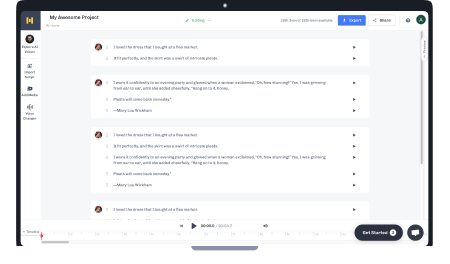How to Project Your Voice: Improve Vocal Projection Techniques

Voice projection refers to using your breath, body, and mouth the right way. Most of us never learned that. But by applying proper vocal techniques, your voice can sound stronger, clearer, and more confident without stressing your throat.
What most of us don’t realize is that projection isn’t just for voiceover artists, actors, or singers. It’s for anyone who wants to be heard, especially in contexts like public speaking, in meetings, on calls, and in life as such.
In this article, we’ll talk about how to project your voice with confidence, improve vocal projection, and boost voice clarity. We’ll also discuss how Murf AI can help enhance your voice quality in the final output when you’re recording or creating content.
Understanding Voice Quality & Projection
Simply put, voice projection is a vocal technique that enables you to be heard in all corners of the room without the need for straining your voice or shouting. Proper voice projection will ensure you sound loud and clear to your audience.
But how do you get a louder voice? It requires breath control, correct use of your vocal cords, and knowing how to work with your body (belly, throat, nose, vocal cords, et al).
That’s not all. Good voice projection also requires you to use your mouth so that you can maintain a steady tone. This might seem difficult at first, but simple exercises, practice, and specific techniques will get you there in no time.
Why Is Voice Projection Important?
Voice projection means making your voice sound louder and clearer without shouting. It basically refers to the way you speak, so even the people at the back of the room can hear you clearly.
Whether it is a public speaking platform, meeting, classroom, or a stage performance, your audience will stop listening if they can’t hear you. It is, therefore, important that your voice reaches every person in the room so you have their complete attention.
- A strong speaking voice and clear tone make you sound confident, even if you’re nervous.
- Remember, good vocal projection means using your vocal cords and lungs (not your throat), and exercising breath control. This also works as a great way to prevent strain to your throat.
- Projecting your voice leads to an improved voice quality that’s clearer and steadier.
- There’s no need to shout to be heard. Daily practice speaking, vocal exercises, and warm up exercises will help your voice get louder and more controlled.
Voice Projection Tips and Techniques
A clear voice projection is a key indicator of the speaker’s confidence. But how do you sound eloquent? Here are a few tips that will help you clearly project your voice.
Correct Your Posture & Improve Body Language
Your voice cannot travel to your audience without a proper medium. This is where your body plays a huge role. When speaking, make sure to stand straight with your feet firmly planted to the floor, and chest open. Avoid slouching or locking your knees. Remember, a balanced upper body will allow your lungs to expand. As a result, the sound waves will move freely.
Breathe from Your Belly During Public Speaking
Of course, you know how to inhale and exhale through your nose. But when you need to speak louder, try this: Take a deep breath. Did your shoulders rise? That’s not what you want. You want to breathe from your belly, focusing your breath towards your belly button. Doing this will result in diaphragmatic breathing. Here, the more air you breathe, the more support your vocal cords will get, and the fuller your voice will sound.
Perform Warm Up Exercises
You wouldn’t miss stretching your limbs before a workout, would you? Similarly, don’t forget about your vocal warm-ups before that big theatre performance to open up your voice. Start with simple vocal exercises, like humming, lip trills, or tongue twisters. The aim is to jumpstart your vocal folds for a louder and clearer voice.

Use Your Chest to Produce Sound
Breathing from your belly and exercising your vocal cords should eventually lead to you producing sounds from your chest. When doing so, you might feel a vibration in your chest while humming or when trying to reach a higher pitch . This totally normal reaction is called resonance, and helps you with speaking louder without shouting.
Practice Speaking as You Exhale
Many people tend to get breathless while they’re still speaking. This can be prevented with adequate practice. Try speaking normally while exhaling every now and then. There’s no need to hold your breath in or rush your words. Regular practice will make your tone clear and volume consistent.
Pace Your Speech
Speaking faster than normal will only make your voice sound unclear and weak. It’s always better to slow down, enunciate your consonants, and open your mouth when you talk. Crisp and articulate speech is sure to make its way to the last row of the audience, even if you’re speaking in a large room.
Simulate the Situation
Don’t only practice in front of a mirror. Try projecting in a quiet room, then a noisy one. Record yourself. Walk around while speaking. Imagine you’re delivering your words to the back wall, and not only the person in front of you.
Support Your Voice
Shouting can put a massive strain on your vocal cords. It is, therefore, important to support your voice with sufficient breath and body control instead of just forcing it out. In other words, use your lungs and diaphragm to produce the sound.
The above-mentioned techniques can transform your overall voice quality. Whether you’re teaching in a crowded classroom, recording an informative podcast, or performing live on stage, proper voice projection can add the much-needed weight to your words, enabling your audience to listen effortlessly.
Vocal Exercises That Help Improve Voice Projection
Anyone who uses their voice to get their work done should make sure they cater to their audience’s demand for crystal clear speech. Here are a few voice projection exercises in this regard. Most voice coaches will recommend doing them about 30 minutes prior to your performance for 15-20 minutes should help you warm up your vocal cords to deliver their best.
Sharp exhales: Take a deep breath in. Next, release it sharply and quickly in 50 exhales.
Stretches: Raise your arms and move them to the opposite side to stretch your torso, activate your core, and project a better voice.
Slides: Go through vocal slides with increasing intervals to warm up your vocal folds.
Elocution: Improve your diction by increasing the volume of your voice with every piece you practice.
Flexes: Increase your voice from low to high and from quiet to loud to expand your range.
Lip flutters: Make raspberries with your lips to decrease later resistance when projecting your voice.
Yawn: Pretend like you’re yawning, but with your mouth closed. This will open up your jaw, giving you a wider range when you speak.
Murf AI: Your Trusted Tool for Voice Enhancement

While Murf doesn’t directly help with voice projections, it can enable speakers, actors, educators, marketers, influencers, and podcasters to produce clearer speech. Murf Studio's AI voice generator is an AI-powered tool that can dramatically cut down production time from months to days.
Users can choose from over 200 professional voices and more than 15 speaking styles to deliver a natural tone with complete control over pitch, pace, intonation and pronunciation.
Murf also offers superior customization features to create ultra realistic speech with precision. You can also clone your voice or use the voice changer feature to generate the exact voice you need for every audio piece.
Some of its standout features include:
Say It My Way: A proprietary technology that allows you to mimic intonations, pacing, and pitch to achieve the exact delivery your content needs.
Variability: Generate multiple takes of any line to compare and select the best version. This feature maximizes choice in your voiceover creation.
Murf Speech Gen 2: Our 2nd generation Text-to-Speech model produces AI voiceovers indistinguishable from human speech.
Word-Level Emphasis: Emphasize different words to capture your exact intention. This granular control helps you convey complex ideas effectively.
MultiNative Voices: Switch between languages within or across sentences, capturing the natural flow of multilingual conversations.
Shared Pronunciation Library: Create, and store custom pronunciations for brand-specific terms and industry terminology to ensure correct and consistent usage.
If you’re looking for quick and efficient results for any kind of voice acting or audio content production, Murf is all you need. Try it for free now!

Frequently Asked Questions
How to project voice easily?
.svg)
Projecting your voice can seem challenging initially, but can get easier with regular practice. Start with breathing deeply and activating your upper body. Maintain an erect posture, open your mouth, and use more air from your belly rather than throat. Focus on achieving clarity in your voice, not raising your volume. You can also perform vocal delivery to develop a louder, clearer speaking voice over time.
How to improve voice projection?
.svg)
Improving voice projection takes practice. For starters, try speaking in a large room. Use breath control and vocal projection exercises like humming and tongue twisters. Make sure to warm up your vocal cords daily before any delivery. Be consistent and your voice will sound louder and more focused over time.
What are AI voices?
.svg)
You can think of AI voices as digital versions of the human voice. They’re created using text-to-speech technology. Murf AI offers realistic voiceovers with natural tone, clarity, and volume control to help users improve their speech sound for podcasts, videos, or presentations.
How do I project my voice without yelling?
.svg)
Yelling typically requires effort from your throat. Projecting your voice, on the other hand, involves using your breath and diaphragm. For best results, inhale more air, speak while you exhale, and relax your neck and jaw. Remember, supporting your voice is key to improved vocal control and clear articulation.
Why do I struggle to project my voice?
.svg)
This is common among beginners, and the culprits include shallow breathing, strain on the throat, bad posture, inadequate warm up, and poor breath control. With practice and the right technique, however, your voice can gain strength, weight, and clarity.














